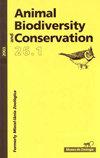生物地理学需要物种吗?
IF 1
4区 环境科学与生态学
Q3 BIODIVERSITY CONSERVATION
引用次数: 1
摘要
使用不同物种概念定义的物种的不对等性最近被强调为保护工作的严重障碍。那么问题来了,生物地理学研究,尤其是宏观生态学研究,在多大程度上也可能受到与多物种数据集有关的众多问题的阻碍。对物种在空间尺度上的含义进行研究揭示了一个重要的不连续性。除了备受争议的物种概念之外,“物种”一词实际上描述了两个截然不同的概念。其中一个适用于当地规模,在社区生态学背景下至关重要。第二种是指全球生物多样性清单中的非等效单位,可供参考,但在分析方面存在问题。事实上,大多数生物地理学研究都与那些中间空间尺度有关,而这两种意义都不真正适用。在一个或另一个方面具有可比性的多物种谱系(如同龄谱系和相似范围谱系)可能是检验生物地理学假设的更准确的单位本文章由计算机程序翻译,如有差异,请以英文原文为准。
Does biogeography need species?
The non–equivalence of species defined using different species concepts has recently been highlighted as a serious impediment for conservation efforts. The question arises then, to what extent biogeographical studies, and especially macroecological studies, might also be hampered by the numerous problems pertaining to multi–species datasets. An examination of what is meant by species across spatial scales reveals an important discontinuity. Over and above the much–debated species concepts the word ‘species’ describes, in fact, two distinct ideas. One, applicable at the local scale, is critical in a community ecology context. The second refers to non–equivalent units in the global inventory of biodiversity, useful for reference purpose, but problematic where analysis is concerned. The majority of biogeographical studies are in fact relevant to those intermediate spatial scales where neither meaning truly applies. Multi–species lineages that are comparable in one or another respect (such as equal–age lineages and similar–range lineages) are probably more accurate units for testing biogeographical hypotheses
求助全文
通过发布文献求助,成功后即可免费获取论文全文。
去求助
来源期刊

Animal Biodiversity and Conservation
农林科学-动物学
CiteScore
2.00
自引率
0.00%
发文量
21
审稿时长
>12 weeks
期刊介绍:
Animal Biodiversity and Conservation (antes Miscel·lània Zoològica) es una revista interdisciplinar, publicada desde 1958 por el Museu de Ciències Naturals de Barcelona. Incluye artículos de investigación empírica y teórica en todas las áreas de la zoología (sistemática, taxonomía, morfología, biogeografía, ecología, etología, fisiología y genética) procedentes de todas las regiones del mundo. La revista presta especial interés a los estudios que planteen un problema nuevo o introduzcan un tema nuevo, con hipòtesis y prediccions claras, y a los trabajos que de una manera u otra tengan relevancia en la biología de la conservación. No se publicaran artículos puramente descriptivos, o artículos faunísticos o corológicos en los que se describa la distribución en el espacio o en el tiempo de los organismes zoológicos.
 求助内容:
求助内容: 应助结果提醒方式:
应助结果提醒方式:


